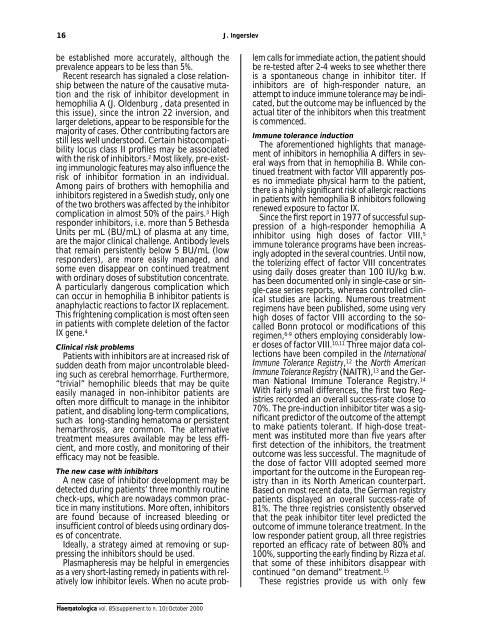Haematologica 2000;85:supplement to no. 10 - Supplements ...
Haematologica 2000;85:supplement to no. 10 - Supplements ...
Haematologica 2000;85:supplement to no. 10 - Supplements ...
You also want an ePaper? Increase the reach of your titles
YUMPU automatically turns print PDFs into web optimized ePapers that Google loves.
16<br />
J. Ingerslev<br />
be established more accurately, although the<br />
prevalence appears <strong>to</strong> be less than 5%.<br />
Recent research has signaled a close relationship<br />
between the nature of the causative mutation<br />
and the risk of inhibi<strong>to</strong>r development in<br />
hemophilia A (J. Oldenburg , data presented in<br />
this issue), since the intron 22 inversion, and<br />
larger deletions, appear <strong>to</strong> be responsible for the<br />
majority of cases. Other contributing fac<strong>to</strong>rs are<br />
still less well unders<strong>to</strong>od. Certain his<strong>to</strong>compatibility<br />
locus class II profiles may be associated<br />
with the risk of inhibi<strong>to</strong>rs. 2 Most likely, pre-existing<br />
immu<strong>no</strong>logic features may also influence the<br />
risk of inhibi<strong>to</strong>r formation in an individual.<br />
Among pairs of brothers with hemophilia and<br />
inhibi<strong>to</strong>rs registered in a Swedish study, only one<br />
of the two brothers was affected by the inhibi<strong>to</strong>r<br />
complication in almost 50% of the pairs. 3 High<br />
responder inhibi<strong>to</strong>rs, i.e. more than 5 Bethesda<br />
Units per mL (BU/mL) of plasma at any time,<br />
are the major clinical challenge. Antibody levels<br />
that remain persistently below 5 BU/mL (low<br />
responders), are more easily managed, and<br />
some even disappear on continued treatment<br />
with ordinary doses of substitution concentrate.<br />
A particularly dangerous complication which<br />
can occur in hemophilia B inhibi<strong>to</strong>r patients is<br />
anaphylactic reactions <strong>to</strong> fac<strong>to</strong>r IX replacement.<br />
This frightening complication is most often seen<br />
in patients with complete deletion of the fac<strong>to</strong>r<br />
IX gene. 4<br />
Clinical risk problems<br />
Patients with inhibi<strong>to</strong>rs are at increased risk of<br />
sudden death from major uncontrolable bleeding<br />
such as cerebral hemorrhage. Furthermore,<br />
“trivial” hemophilic bleeds that may be quite<br />
easily managed in <strong>no</strong>n-inhibi<strong>to</strong>r patients are<br />
often more difficult <strong>to</strong> manage in the inhibi<strong>to</strong>r<br />
patient, and disabling long-term complications,<br />
such as long-standing hema<strong>to</strong>ma or persistent<br />
hemarthrosis, are common. The alternative<br />
treatment measures available may be less efficient,<br />
and more costly, and moni<strong>to</strong>ring of their<br />
efficacy may <strong>no</strong>t be feasible.<br />
The new case with inhibi<strong>to</strong>rs<br />
A new case of inhibi<strong>to</strong>r development may be<br />
detected during patients’ three monthly routine<br />
check-ups, which are <strong>no</strong>wadays common practice<br />
in many institutions. More often, inhibi<strong>to</strong>rs<br />
are found because of increased bleeding or<br />
insufficient control of bleeds using ordinary doses<br />
of concentrate.<br />
Ideally, a strategy aimed at removing or suppressing<br />
the inhibi<strong>to</strong>rs should be used.<br />
Plasmapheresis may be helpful in emergencies<br />
as a very short-lasting remedy in patients with relatively<br />
low inhibi<strong>to</strong>r levels. When <strong>no</strong> acute problem<br />
calls for immediate action, the patient should<br />
be re-tested after 2-4 weeks <strong>to</strong> see whether there<br />
is a spontaneous change in inhibi<strong>to</strong>r titer. If<br />
inhibi<strong>to</strong>rs are of high-responder nature, an<br />
attempt <strong>to</strong> induce immune <strong>to</strong>lerance may be indicated,<br />
but the outcome may be influenced by the<br />
actual titer of the inhibi<strong>to</strong>rs when this treatment<br />
is commenced.<br />
Immune <strong>to</strong>lerance induction<br />
The aforementioned highlights that management<br />
of inhibi<strong>to</strong>rs in hemophilia A differs in several<br />
ways from that in hemophilia B. While continued<br />
treatment with fac<strong>to</strong>r VIII apparently poses<br />
<strong>no</strong> immediate physical harm <strong>to</strong> the patient,<br />
there is a highly significant risk of allergic reactions<br />
in patients with hemophilia B inhibi<strong>to</strong>rs following<br />
renewed exposure <strong>to</strong> fac<strong>to</strong>r IX.<br />
Since the first report in 1977 of successful suppression<br />
of a high-responder hemophilia A<br />
inhibi<strong>to</strong>r using high doses of fac<strong>to</strong>r VIII, 5<br />
immune <strong>to</strong>lerance programs have been increasingly<br />
adopted in the several countries. Until <strong>no</strong>w,<br />
the <strong>to</strong>lerizing effect of fac<strong>to</strong>r VIII concentrates<br />
using daily doses greater than <strong>10</strong>0 IU/kg b.w.<br />
has been documented only in single-case or single-case<br />
series reports, whereas controlled clinical<br />
studies are lacking. Numerous treatment<br />
regimens have been published, some using very<br />
high doses of fac<strong>to</strong>r VIII according <strong>to</strong> the socalled<br />
Bonn pro<strong>to</strong>col or modifications of this<br />
regimen, 6-9 others employing considerably lower<br />
doses of fac<strong>to</strong>r VIII. <strong>10</strong>,11 Three major data collections<br />
have been compiled in the International<br />
Immune Tolerance Registry, 12 the North American<br />
Immune Tolerance Registry (NAITR), 13 and the German<br />
National Immune Tolerance Registry. 14<br />
With fairly small differences, the first two Registries<br />
recorded an overall success-rate close <strong>to</strong><br />
70%. The pre-induction inhibi<strong>to</strong>r titer was a significant<br />
predic<strong>to</strong>r of the outcome of the attempt<br />
<strong>to</strong> make patients <strong>to</strong>lerant. If high-dose treatment<br />
was instituted more than five years after<br />
first detection of the inhibi<strong>to</strong>rs, the treatment<br />
outcome was less successful. The magnitude of<br />
the dose of fac<strong>to</strong>r VIII adopted seemed more<br />
important for the outcome in the European registry<br />
than in its North American counterpart.<br />
Based on most recent data, the German registry<br />
patients displayed an overall success-rate of<br />
81%. The three registries consistently observed<br />
that the peak inhibi<strong>to</strong>r titer level predicted the<br />
outcome of immune <strong>to</strong>lerance treatment. In the<br />
low responder patient group, all three registries<br />
reported an efficacy rate of between 80% and<br />
<strong>10</strong>0%, supporting the early finding by Rizza et al.<br />
that some of these inhibi<strong>to</strong>rs disappear with<br />
continued “on demand” treatment. 15<br />
These registries provide us with only few<br />
<strong>Haema<strong>to</strong>logica</strong> vol. <strong>85</strong>(<strong>supplement</strong> <strong>to</strong> n. <strong>10</strong>):Oc<strong>to</strong>ber <strong>2000</strong>
















